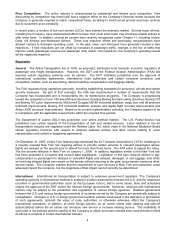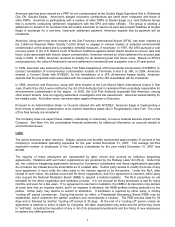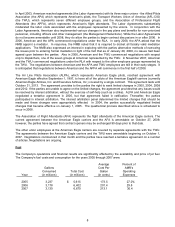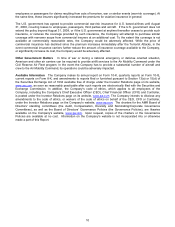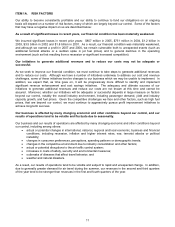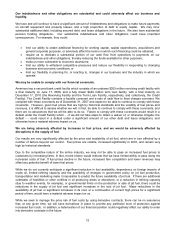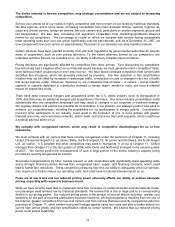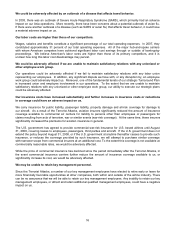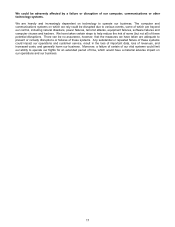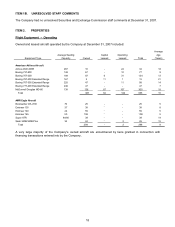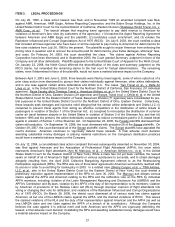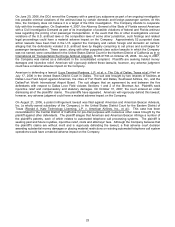American Airlines 2007 Annual Report Download - page 17
Download and view the complete annual report
Please find page 17 of the 2007 American Airlines annual report below. You can navigate through the pages in the report by either clicking on the pages listed below, or by using the keyword search tool below to find specific information within the annual report.14
We may need to raise additional funds to maintain sufficient liquidity, but we may be unable to do so on
acceptable terms.
To maintain sufficient liquidity as we continue to implement our restructuring and cost reduction initiatives, and
because we have significant debt, lease, pension and other obligations in the next several years, we may need
continued access to additional funding.
Our ability to obtain future financing has been reduced because we have had fewer unencumbered assets
available than in years past. A very large majority of our aircraft assets (including most of our aircraft eligible for
the benefits of Section 1110 of the U.S. Bankruptcy Code) have been encumbered. Also, the market value of our
aircraft assets has declined in recent years and those assets may not maintain their current market value.
Since the terrorist attacks of September 2001, which we refer to as the Terrorist Attacks, our credit ratings have
been lowered to significantly below investment grade. These reductions have increased our borrowing costs and
otherwise adversely affected borrowing terms, and limited borrowing options. Additional reductions in our credit
ratings could further increase borrowing or other costs and further restrict the availability of future financing.
A number of other factors, including our financial results in recent years, our substantial indebtedness, the difficult
revenue environment we face, our reduced credit ratings, high fuel prices, and the financial difficulties
experienced in the airline industry, adversely affect the availability and terms of financing for us. As a result, there
can be no assurance that financing will be available to us on acceptable terms, if at all. An inability to obtain
additional financing on acceptable terms could have a material adverse impact on us and on our ability to sustain
our operations over the long term.
Our corporate or business strategy may change.
In light of the rapid changes in the airline industry, we evaluate our assets on an ongoing basis with a view to
maximizing their value to us and determining which are core to our operations. We also regularly evaluate our
corporate and business strategies, and they are influenced by factors beyond our control, including changes in
the competitive landscape we face. Our corporate and business strategies are, therefore, subject to change.
In October 2007, we announced that we were conducting a strategic value review involving, among other things,
AMR Eagle, our regional airline, American Beacon Advisors, our investment advisory subsidiary and AAdvantage,
the world’s most popular frequent flyer program, and this review is continuing. The purpose of the review is to
determine whether there exists the potential for unlocking additional stockholder value with respect to one or more
of these strategic assets through some type of separation transaction. A separation may take the form of a spin-
off transaction, a public offering of securities, a sale to a third party or otherwise, and we may have discussions
from time-to-time with third parties involving these possibilities. Pursuant to this review, we announced on
November 28, 2007 that we plan to divest AMR Eagle. There can be no assurances that our strategic review will
lead to the completion of any separation transactions or as to the impact of these transactions on stockholder
value or on us.
Our business is subject to extensive government regulation, which can result in increases in our costs,
limits on our operating flexibility, reductions in the demand for air travel, and competitive disadvantages.
Airlines are subject to extensive domestic and international regulatory requirements. Many of these requirements
result in significant costs. For example, the FAA from time to time issues directives and other regulations relating
to the maintenance and operation of aircraft, and compliance with those requirements drives significant
expenditures. In addition, the ability of U.S. carriers to operate international routes is subject to change because
the applicable arrangements between the United States and foreign governments may be amended from time to
time, or because appropriate slots or facilities are not made available.


